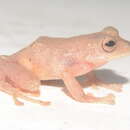Description
provided by AmphibiaWeb articles
Head is as wide as the body and as wide as it is long. The eye to nostril distance ranges from 89-113% diameter of eye (1 male and 7 females were sampled; male had 90.6%). Snout is longer than length of eye. Loreal region flat and sloping abruptly to lips (which are weakly flared). Most individuals have a minute conical tubercle on the upper eyelid. Supratympanic fold is indistinct and the tympanic annulus is round with the upper border under the fold. Postrictal tubercles are small and conical. Vomerine odontophores are posteromedially arranged relative to the choanae and separated medially by a distance equal to the width of one odontophore, each larger than a choana. Five or six teeth are present in a transverse row Dorsal skin is shagreen and coarser on flanks. It is finely granular on the upper surfaces of the limbs. Skin on belly is areolate and that on throat is smooth. Palmar tubercle is bifid and slightly larger than the oval thenar. Subarticular tubercles are round. There is a fringe present along the outer edge of palm and finger IV, disc on thumb is narrow while finger II is as wide as the tympanic annulus. Discs on fingers III and IV are larger than tympanic annulus. In life, the coloration of the dorsum is a pale creamy tan to dusky yellow. If pale spots are present their coloration is that of a pale yellow to a pale orange. Throat and venter are white. Iris is pale greenish-gray to coppery orange with brown flecks or fine black reticulation. Pristimantis eugeniae is most similar to P. nyctophylax which is of equal size on the Pacific versant of the Ecuadorian Andes. However, Pristimantis nyctophylax, unlike P. eugeniae, has small tubercles on the upper eyelid and heel, a more angular canthus rostralis, areolate plantar surface and the posterior surfaces of the thighs are brown with cream flecks.
Distribution and Habitat
provided by AmphibiaWeb articles
Individuals were collected in cloud forests at 2-4 m above ground level. They are known from 1700-2010 m in elevation in the upper valley of the Rio Pilaton in Provincia Pichincha, Ecuador.
Life History, Abundance, Activity, and Special Behaviors
provided by AmphibiaWeb articles
Not much is known about this species. Lynch and Duellman (1997) state, with regards to JDL having to climb up a tree to catch one, “the apparent rarity of this species may reflect the frog’s use of a stratum above the collecting zone of most biologists.”
Pristimantis eugeniae: Brief Summary
provided by wikipedia EN
Pristimantis eugeniae is a species of frog in the family Strabomantidae.
It is endemic to Ecuador. Its natural habitat is tropical moist montane forests. It is threatened by habitat loss.
- license
- cc-by-sa-3.0
- copyright
- Wikipedia authors and editors

